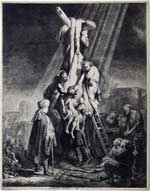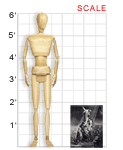VAM galleries including this work:
Berea College | World of the Spirit || VAM Home
Rembrandt Harmensz van Rijn (Dutch, 1606-1669)
THE DESCENT FROM THE CROSS, 1633
Etching; 16-3/8" X 20-7/8"
Poole Gift in 1965, 180.E.180
By permission of Berea College
The Descent from the Cross is one of roughly 300 etchings created by the 17th-century Dutch master Rembrandt Harmensz van Rijn. In it, bystanders watch with expressions of pained disbelief as Jesus’ lifeless body is removed from the cross. Rembrandt’s artistic precision and masterful use of chiaroscuro render the figures surprisingly sympathetic and lifelike.
How To Create an Etching—Etchings are made by using a needle to draw on a wax-covered metal plate and then immersing the plate in an acid. Where the needle removed the wax, the acid erodes the exposed metal and creates the “etch.” The depth of the etch is increased by increasing the length of stay in the acid. The deeper the etch, the darker the print will be. The print is made by covering the plate in ink, wiping the surface clean so that ink remains only in the etched areas, and then pressing the plate on paper.
About the Artist
Rembrandt van Rijn was born in the Netherlands in 1606. Although his family had little money, his parents recognized the value of a good education, and Rembrandt was sent to Latin school and then to the University of Leiden. But while his parents desired a professional career for their son, Rembrandt’s true interest was art, and he left the university shortly after enrolling to study with a local master. After completing his training, he moved to Amsterdam to study with artist Pieter Lastman. He mastered his lessons in six months and then returned to Leiden to begin training students of his own.
Rembrandt enjoyed great success for many years, until his taste for a lavish lifestyle drove the artist to near bankruptcy and personal losses began to affect his emotional stability. In addition, the artistic tastes of the popular audience had shifted considerably toward the end of his career. Rembrandt’s refusal to conform to the new style ultimately lost him the favor of his contemporaries.
A prolific artist, he produced approximately 600 paintings and 1,400 drawings as well as the 300 etchings. A master of light and shadow, Rembrandt painted landscapes, portraits, self-portraits, and religious subjects. His portraits demonstrate a keen ability to penetrate to his subject’s character, and his landscapes provide a vivid record of 17th-century Dutch life.
Classroom Ideas
Discussion: In The Descent from the Cross, Rembrandt has created a powerful composition. Discuss the elements of the composition. What is the first thing your eyes are drawn to? Has Rembrandt put more emphasis on the figure of Jesus than on the other characters? If so, how has he achieved this emphasis?
Activity: Rembrandt expresses the deep sadness of this occasion in several ways. You can see it in the emotional and distraught looks on the individual faces, and you can sense it by the way the darkness is pierced by one ray of light that shines on Jesus. In what other ways can you express emotion through art? Think of an event in your life that made you feel a very strong emotion. How might you portray this emotion in a two-dimensional work? For example, warm colors might signify a happy occasion, while a skewed perspective might indicate something entirely different. Create a drawing using elements of composition to express emotion.
Links
Visit these museums for more information about Rembrandt as well as images of his work:
- National Gallery of Art (which has 93 images of his work online)
[www.nga.gov/cgi-bin/pbio?26200] - Art Institute of Chicago (19 images online)
[www.artic.edu/aic/exhibitions/rembrandt.html] - Getty Museum (16 images online)
[www.getty.edu/art/collections/bio/a473-1.html]


